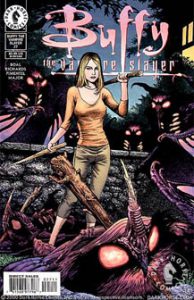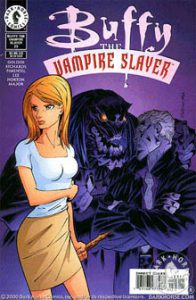“Buffy the Vampire Slayer Classic” finds its groove with Issues 21-27 (May-November 2000), ironically a time period when it doesn’t have a regular writer (Andi Watson bowed out in Issue 19, and Fassbender/Pascoe start their run in Issue 28). As I noted in my review of the previous batch, novel writer Christopher Golden didn’t hit a home run in his first couple efforts, but he shows he’s a fast learner on the five-part “Blood of Carthage” (21-25), which has all the best traits of his “Buffy” books along with art by Cliff Richards and Joe Pimental that is growing on me.
The comics’ first venture into Season 4, “Blood of Carthage” is set after “Pangs” (4.8), as Spike makes reference to being tied up in a chair, and probably before “Something Blue” (4.9), as there is no mention of the crazy events of that episode where Buffy and Spike are under a love spell. Anya joins the comic for the first time. And in a nice tie-in to Golden and Nancy Holder’s book “Immortal,” so does the gang’s ghost-Slayer friend Lucy Hanover and demon ally Tergazzi, who has purple skin and facial horns.
One of the themes running through the story is that Xander still sees Willow as his sidekick, something she quietly resents. Of course, it’s Spike who sees this and spells it out to Xander. Flashback pages illustrate Willow and Xander’s younger days while also showing an earlier appearance of Sunnydale’s bogeyman, Mad Jack. (This is Golden’s second go at a creature of Sunnydale urban myth, following “Halloween Rain.”)
Drawn by Chynna Clugston-Major, the flashbacks show Willow and Xander when they are about 8 years old. They are heart-achingly cute, not only because of Clugston-Major’s anime-esque art that perfectly captures the friends at that age, but also because the scenes are spot-on. In Issue 21, Sheila Rosenberg – in the mothering-from-a-textbook mode she demonstrates in “Gingerbread” (3.11), warns her daughter about Xander’s influence.
Sheila: “I mean, honestly, Willow. If Xander jumped off a bridge, would you jump after him?”
Willow: “Uhm … no?”
Sheila: “You don’t sound so sure.”
The overarching theme is that Buffy – after mistakenly killing a guardian demon in Issue 21 – resolves to put Slaying ahead of school. This is something that played as an undercurrent on the TV show (where eventually Buffy drifts away from college without much comment) but which Golden brings to the fore. Both sides of the argument are nicely illustrated in a scene in the girls’ dorm room in Issue 23:
Willow: “If you leave (UC-Sunnydale), that’s like saying you don’t have any future other than slaying, that there’s no Buffy anymore, just the Slayer.”
Buffy: “The cost of not doing my homework on Mad Jack may be thousands of lives. I want a life. But I don’t want anyone else to pay for it.”
Golden also touches on the “Life is hard, period” theme that would dominate the end of Season 5 and all of Season 6. When Buffy tells Lucy in Issue 25 that “It’s hard work, the whole living thing, like one long battle,” it foreshadows her famous line to Dawn in “The Gift” (5.22): “The hardest thing in this world is to live in it.” The writer nicely peppers this dialogue into the epic final fight against a massive, ancient demon, where our heroes are perched atop it like ants, trying to land blows. Such an image would become a cliché in the post-TV “Buffy” and “Angel” comics, which also generally don’t do as good a job as Golden at balancing action and story.

4.5 stars

Up next is another winner, Chris Boal’s “The Heart of a Slayer, Parts 1 and 2“ (26-27), which is set after “Hush” (4.10) – as Riley (making his comic debut) and Buffy know about each other’s roles – but apparently before “A New Man” (4.12), when Buffy begins to work directly with Riley and The Initiative. Boal nicely taps into Buffy’s inability to balance secret trysts with Riley with hangout time with Willow and Xander during this period. He also debuts Buffy’s four-barreled stake-gun (perhaps courtesy of Riley), which can fire stakes like bullets.
The heart of the story is Adja, an 11th century Slayer who has chased a demon through time portals to present-day Sunnydale. We get good details about Adja: She speaks a Gothic language that Giles struggles to translate, and existed in a time before soap, judging by her “indelible odor,” as Giles puts it. An exasperated Buffy wonders what’s up with all the other Slayers (ironic, considering her actions in Season 7, when she chooses to share her power with hundreds of girls), referencing Faith, Kendra and a Slayer/vampire named Beth who must be from a comic that I haven’t gotten to yet on this re-read.
After the demon rips out Adja’s heart, which is also his undoing, Giles notes that her name translates to “One who is already dead.” Additionally, Adja’s terms for Buffy, “Nasjands,” translates as “The Savior.” While it’s unintentional on Boal’s part, this is a nice tie-in to Buffy’s world-saving actions in Seasons 5 and 7. Perhaps Adja travels even farther into the future at one point while chasing the demon. Although the time portals and the fact that tearing out a Slayer’s heart is the death-knell for this demon are not sufficiently explained, “Heart of a Slayer” has emotional depth and a saga-wide scope that makes it work.
4 stars
Click here for an index of all of John’s “Buffy” and “Angel” reviews.

